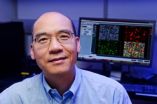(Press-News.org) UT Southwestern Medical Center researchers have identified a crucial link between high levels of insulin and pathways that lead to obesity, a finding that may have important implications when treating diabetes.
Researchers with the UT Southwestern's Touchstone Center for Diabetes found that giving mice high levels of insulin, which is typically done to counter the effects of diabetes or insulin resistance in Type 2 diabetes, also fosters processes that lead to obesity.
The discovery was made by studying mice engineered to lack receptors for a hormone called glucagon.
Glucagon spurs the liver's production of glucose into the bloodstream and thus maintains the fuel supply for the brain. Insulin blocks the secretion of glucagon, opposes glucagon action on the liver, and instructs the body to take up glucose from the blood. Type 2 diabetics cannot respond properly to insulin and have uncontrolled glucagon production, thereby causing their livers to overproduce glucose, contributing to high blood-sugar levels. Insulin is often given to people with type 2 diabetes to try to overcome insulin-resistance and lower the levels of glucose in the bloodstream.
But insulin also signals the body to produce fat, so when given the high levels of insulin needed to control excess glucose, mice become fat, explained corresponding author Dr. Michael Roth, Professor of Biochemistry at UT Southwestern and a member of the Touchstone Diabetes Center.
"We found that mice lacking the receptor for glucagon cannot get fat unless they are given the high levels of insulin found in mice (and humans) that have type 2 diabetes," said Dr. Roth, who holds the Diane and Hal Brierley Distinguished Chair in Biomedical Research. "This result suggests that the high levels of insulin found in those who develop insulin resistance and type 2 diabetes are a contributor to obesity and its complications."
Dr. Roth cautioned that if this response also happens in humans, then treating patients with type 2 diabetes with higher than normal amounts of insulin could contribute to the development of obesity.
The findings suggest that physicians may need to reconsider use of intensive insulin therapy to control hyperglycemia (high blood-sugar levels) in obese, diabetic patients with hyperinsulinemia (overproduction of insulin). In addition, the findings suggest that suppressing glucagon action could prevent hyperinsulinemia, without causing diabetes. The research team found that suppressing glucagon in obese, insulin-resistant, type 2 diabetic mice reduced blood glucose back to normal levels.
Glucagon and insulin normally counteract each other as part of an ongoing effort to stabilize blood-sugar levels. The glucagon hormone is produced and released by the pancreas in response to low concentrations of insulin and, conversely, glucagon release is suppressed by high levels of insulin in the bloodstream. The balance between the two hormones is disrupted in type 2 diabetics by the insulin that is given to control high glucose levels. This excess insulin, in turn, causes the body to produce excess fat. The new findings lead the authors to suggest that the high insulin levels actually aggravate diabetes. The optimal therapy, they propose, should be diet restriction and reducing glucagon levels.
According to estimates of the World Health Organization (WHO), 347 million people worldwide have diabetes, 90 percent of whom are affected by type 2 diabetes. Although previously only seen in adults, type 2 diabetes is now occurring in children, and can include complications such as an increased risk of heart disease and stroke, nerve damage, and eye disease.
INFORMATION:
The work, published in the journal Proceedings of the National Academy of Sciences, builds upon original research by Nobel laureates and Regental Professors Dr. Michael Brown, Director of the Jonsson Center for Molecular Genetics, and Dr. Joseph Goldstein, Chairman of Molecular Genetics, who showed that insulin increases lipogenesis, the production of fat, and demonstrated the role of insulin in the activity of SREBP family of transcription factors. Dr. Goldstein holds the Julie and Louis A. Beecherl, Jr. Distinguished Chair in Biomedical Research and the Paul J. Thomas Chair in Medicine. Dr. Brown holds the W. A. (Monty) Moncrief Distinguished Chair in Cholesterol and Arteriosclerosis Research and the Paul J. Thomas Chair in Medicine.
The current research was supported by grants from Bristol-Myers Squibb, and the Diane and Hal Brierley Distinguished Chair in Biomedical Research, and was partially conducted in laboratories renovated with support from a National Institutes of Health Facilities Grant.
Other researchers involved in the work include senior author Dr. Roger Unger, Professor of Internal Medicine, who holds the Touchstone/West Distinguished Chair in Diabetes Research; Dr. Philipp Scherer, Professor of Internal Medicine and Cell Biology, Director of the Touchstone Center for Diabetes, and holder of the Gifford O. Touchstone, Jr. and Randolph G. Touchstone Distinguished Chair in Diabetes Research; first author Dr. Young Lee, Assistant Professor of Internal Medicine; Dr. Eric Berglund, Assistant Professor in the Advanced Imaging Research Center, and Pharmacology; Dr. William Holland, Assistant Professor of Internal Medicine; Dr. May-yun Wang, Assistant Professor of Internal Medicine; Dr. Xinxin Yu, Research Scientist; Dr. Matthew Evans, Post-Doctoral Researcher; and Dr. Maureen Charron, Professor of the Albert Einstein College of Medicine.
About UT Southwestern Medical Center
UT Southwestern, one of the premier academic medical centers in the nation, integrates pioneering biomedical research with exceptional clinical care and education. The institution's faculty includes many distinguished members, including six who have been awarded Nobel Prizes since 1985. Numbering more than 2,700, the faculty is responsible for groundbreaking medical advances and is committed to translating science-driven research quickly to new clinical treatments. UT Southwestern physicians provide medical care in 40 specialties to nearly 91,000 hospitalized patients and oversee more than 2 million outpatient visits a year.
High insulin levels tied to obesity pathway, new UT Southwestern research shows
2014-08-25
ELSE PRESS RELEASES FROM THIS DATE:
Finding keys to glioblastoma therapeutic resistance
2014-08-25
Researchers at the University of California, San Diego School of Medicine have found one of the keys to why certain glioblastomas – the primary form of a deadly brain cancer – are resistant to drug therapy. The answer lies not in the DNA sequence of the tumor, but in its epigenetic signature. These findings have been published online as a priority report in the journal Oncotarget.
"There is a growing interest to guide cancer therapy by sequencing the DNA of the cancer cell," said Clark Chen, MD, PhD, vice-chairman of Research and Academic Development, UC San Diego Division ...
Gut bacteria that protect against food allergies identified
2014-08-25
The presence of Clostridia, a common class of gut bacteria, protects against food allergies, a new study in mice finds. By inducing immune responses that prevent food allergens from entering the bloodstream, Clostridia minimize allergen exposure and prevent sensitization – a key step in the development of food allergies. The discovery points toward probiotic therapies for this so-far untreatable condition, report scientists from the University of Chicago, Aug 25 in the Proceedings of the National Academy of Sciences.
Although the causes of food allergy – a sometimes deadly ...
Key to universal flu vaccine: Embrace the unfamiliar
2014-08-25
Vaccine researchers have developed a strategy aimed at generating broadly cross-reactive antibodies against the influenza virus: embrace the unfamiliar.
In recent years, researchers interested in a "universal flu vaccine" identified a region of the viral hemagglutinin protein called the stem or stalk, which doesn't mutate and change as much as other regions and could be the basis for a vaccine that is protective against a variety of flu strains.
In an Emory Vaccine Center study, human volunteers immunized against the avian flu virus H5N1 readily developed antibodies ...
SA's Taung Child's skull and brain not human-like in expansion
2014-08-25
The Taung Child, South Africa's premier hominin discovered 90 years ago by Wits University Professor Raymond Dart, never seizes to transform and evolve the search for our collective origins.
By subjecting the skull of the first australopith discovered to the latest technologies in the Wits University Microfocus X-ray Computed Tomography (CT) facility, researchers are now casting doubt on theories that Australopithecus africanus shows the same cranial adaptations found in modern human infants and toddlers – in effect disproving current support for the idea that this early ...
A long childhood feeds the hungry human brain
2014-08-25
EVANSTON, Ill. -- A five-year old's brain is an energy monster. It uses twice as much glucose (the energy that fuels the brain) as that of a full-grown adult, a new study led by Northwestern University anthropologists has found.
The study helps to solve the long-standing mystery of why human children grow so slowly compared with our closest animal relatives.
It shows that energy funneled to the brain dominates the human body's metabolism early in life and is likely the reason why humans grow at a pace more typical of a reptile than a mammal during childhood.
Results ...
Black carbon -- a major climate pollutant -- also linked to cardiovascular health
2014-08-25
Black carbon pollutants from wood smoke are known to trap heat near the earth's surface and warm the climate. A new study led by McGill Professor Jill Baumgartner suggests that black carbon may also increase women's risk of cardiovascular disease.
To investigate the effects of black carbon pollutants on the health of women cooking with traditional wood stoves, Baumgartner, a researcher at McGill's Institute for the Health and Social Policy, measured the daily exposure to different types of air pollutants, including black carbon, in 280 women in China's rural Yunnan province.
Baumgartner ...
Tilted acoustic tweezers separate cells gently
2014-08-25
Precise, gentle and efficient cell separation from a device the size of a cell phone may be possible thanks to tilt-angle standing surface acoustic waves, according to a team of engineers.
"For biological testing we often need to do cell separation before analysis," said Tony Jun Huang, professor of engineering science and mechanics. "But if the separation process affects the integrity of the cells, damages them in any way, the diagnosis often won't work well."
Tilted-angle standing surface acoustic waves can separate cells using very small amounts of energy. Unlike ...
New biomarker highly promising for predicting breast cancer outcomes
2014-08-25
A protein named p66ShcA shows promise as a biomarker to identify breast cancers with poor prognoses, according to research published ahead of print in the journal Molecular and Cellular Biology.
Cancer is deadly in large part due to its ability to metastasize, to travel from one organ or tissue type to another and malignantly sprout anew. The vast majority of cancer deaths are associated with metastasis.
In breast cancer, a process called "epithelial to mesenchymal transition" aids metastasis. Epithelial cells line surfaces which come into contact with the environment, ...
Exposure to toxins makes great granddaughters more susceptible to stress
2014-08-25
Scientists have known that toxic effects of substances known as endocrine disrupting chemicals (EDCs), found in both natural and human-made materials, can pass from one generation to the next, but new research shows that females with ancestral exposure to EDC may show especially adverse reactions to stress.
According to a new study by researchers from The University of Texas at Austin and Washington State University, male and female rats are affected differently by ancestral exposure to a common fungicide, vinclozolin. Female rats whose great grandparents were exposed ...
MU researchers discover protein's ability to inhibit HIV release
2014-08-25
COLUMBIA, Mo. — A family of proteins that promotes virus entry into cells also has the ability to block the release of HIV and other viruses, University of Missouri researchers have found.
"This is a surprising finding that provides new insights into our understanding of not only HIV infection, but also that of Ebola and other viruses," said Shan-Lu Liu, M.D., Ph.D., associate professor in the MU School of Medicine's Department of Molecular Microbiology and Immunology.
The study was recently published in the Proceedings of the National Academy of Sciences. Liu, the ...




